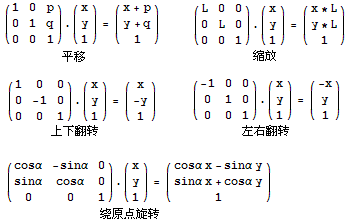NYOJ298 点的变换 矩阵乘法经典
Posted ymzjj
tags:
篇首语:本文由小常识网(cha138.com)小编为大家整理,主要介绍了NYOJ298 点的变换 矩阵乘法经典相关的知识,希望对你有一定的参考价值。
任意门:http://acm.nyist.edu.cn/JudgeOnline/problem.php?pid=298
点的变换
时间限制:2000 ms | 内存限制:65535 KB
难度:5
- 描述
-
平面上有不超过10000个点,坐标都是已知的,现在可能对所有的点做以下几种操作:
平移一定距离(M),相对X轴上下翻转(X),相对Y轴左右翻转(Y),坐标缩小或放大一定的倍数(S),所有点对坐标原点逆时针旋转一定角度(R)。
操作的次数不超过1000000次,求最终所有点的坐标。
提示:如果程序中用到PI的值,可以用acos(-1.0)获得。
- 输入
- 只有一组测试数据
测试数据的第一行是两个整数N,M,分别表示点的个数与操作的个数(N<=10000,M<=1000000)
随后的一行有N对数对,每个数对的第一个数表示一个点的x坐标,第二个数表示y坐标,这些点初始坐标大小绝对值不超过100。
随后的M行,每行代表一种操作,行首是一个字符:
首字符如果是M,则表示平移操作,该行后面将跟两个数x,y,表示把所有点按向量(x,y)平移;
首字符如果是X,则表示把所有点相对于X轴进行上下翻转;
首字符如果是Y,则表示把所有点相对于Y轴进行左右翻转;
首字符如果是S,则随后将跟一个数P,表示坐标放大P倍;
首字符如果是R,则随后将跟一个数A,表示所有点相对坐标原点逆时针旋转一定的角度A(单位是度) - 输出
- 每行输出两个数,表示一个点的坐标(对结果四舍五入到小数点后1位,输出一位小数位)
点的输出顺序应与输入顺序保持一致 - 样例输入
-
2 5 1.0 2.0 2.0 3.0 X Y M 2.0 3.0 S 2.0 R 180
- 样例输出
-
-2.0 -2.0 0.0 0.0
题意概括:如题干
解题思路:
点的变换即向量的变换,即转换为矩阵运算,因为就是做初等变换嘛。

AC code:

1 //题目链接 http://acm.nyist.edu.cn/JudgeOnline/problem.php?pid=298 2 #include <cstdio> 3 #include <iostream> 4 #include <algorithm> 5 #include <cstring> 6 #include <cmath> 7 #define LL long long 8 using namespace std; 9 const int MAXN = 5; 10 const int MAXS = 1e4+2; 11 const double pi = acos(-1.0); 12 int N, M; 13 14 struct mat 15 { 16 double m[MAXN][MAXN]; 17 }base; 18 mat pp[MAXS]; 19 20 mat muti(mat a, mat b) 21 { 22 mat res; 23 memset(res.m, 0, sizeof(res.m)); 24 for(int i = 1; i <= 3; i++){ 25 for(int j = 1; j <= 3; j++) 26 if(a.m[i][j]){ 27 for(int k = 1; k <= 3; k++) 28 res.m[i][k] = (res.m[i][k] + a.m[i][j] * b.m[j][k]); 29 } 30 } 31 return res; 32 } 33 34 mat add(mat a, mat b) 35 { 36 mat res; 37 memset(res.m, 0, sizeof(res.m)); 38 for(int i = 1; i <= 3; i++){ 39 for(int j = 1; j <= 3; j++){ 40 res.m[i][j] = (a.m[i][j] + b.m[i][j]); 41 } 42 } 43 return res; 44 } 45 46 //mat qpow(mat a, int n) 47 //{ 48 // mat res; 49 // memset(res.m, 0, sizeof(res.m)); 50 // for(int i = 1; i <= 3; i++) res.m[i][i] = 1; 51 // 52 // while(n){ 53 // if(n&1) res = muti(res, a); 54 // n>>=1; 55 // a = myti(a, a); 56 // } 57 // return res; 58 //} 59 60 int main() 61 { 62 char com; 63 mat tmp; 64 double a, b; 65 scanf("%d %d", &N, &M); 66 for(int i = 1; i <= N; i++){ 67 scanf("%lf %lf", &a, &b); 68 pp[i].m[1][1] = a; 69 pp[i].m[2][1] = b; 70 pp[i].m[3][1] = 1; 71 } 72 memset(tmp.m, 0, sizeof(tmp.m)); 73 for(int i = 1; i <= 3; i++) tmp.m[i][i] = 1; 74 while(M--){ 75 memset(base.m, 0, sizeof(base.m)); 76 for(int i = 1; i <= 3; i++) base.m[i][i] = 1; 77 getchar(); 78 scanf("%c", &com); 79 if(com == ‘M‘){ 80 scanf("%lf %lf", &a, &b); 81 base.m[1][3] = a; 82 base.m[2][3] = b; 83 } 84 else if(com == ‘X‘){ 85 base.m[2][2] = -1; 86 } 87 else if(com == ‘Y‘){ 88 base.m[1][1] = -1; 89 } 90 else if(com == ‘S‘){ 91 scanf("%lf", &a); 92 base.m[1][1] = a; 93 base.m[2][2] = a; 94 } 95 else if(com == ‘R‘){ 96 scanf("%lf", &a); 97 a = a/180*pi; 98 base.m[1][1] = cos(a); 99 base.m[1][2] = -sin(a); 100 base.m[2][1] = sin(a); 101 base.m[2][2] = cos(a); 102 } 103 tmp = muti(base, tmp); 104 } 105 mat ans; 106 for(int i = 1; i <= N; i++){ 107 // pp[i] = muti(tmp, pp[i]); 108 // printf("%.1f %.1f ", pp[i].m[1][1], pp[i].m[2][1]); 109 ans = muti(tmp, pp[i]); 110 printf("%.1f %.1f ", ans.m[1][1], ans.m[2][1]); 111 } 112 return 0; 113 }
以上是关于NYOJ298 点的变换 矩阵乘法经典的主要内容,如果未能解决你的问题,请参考以下文章
